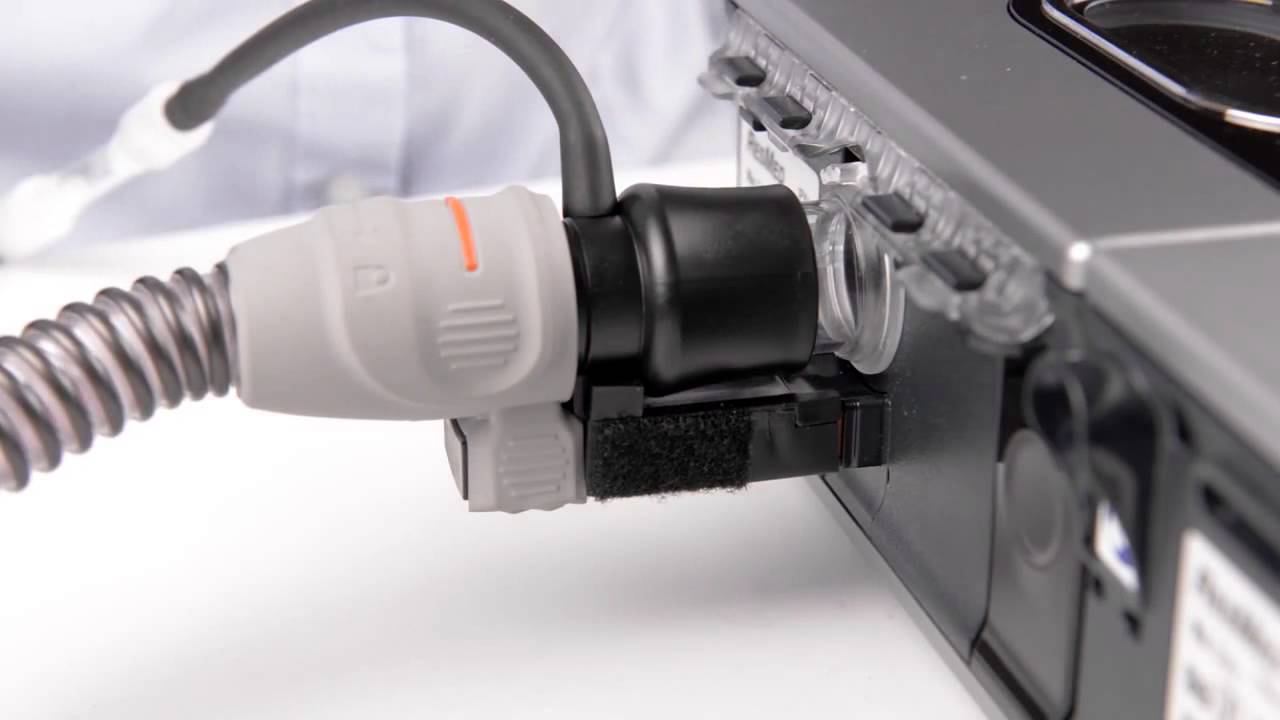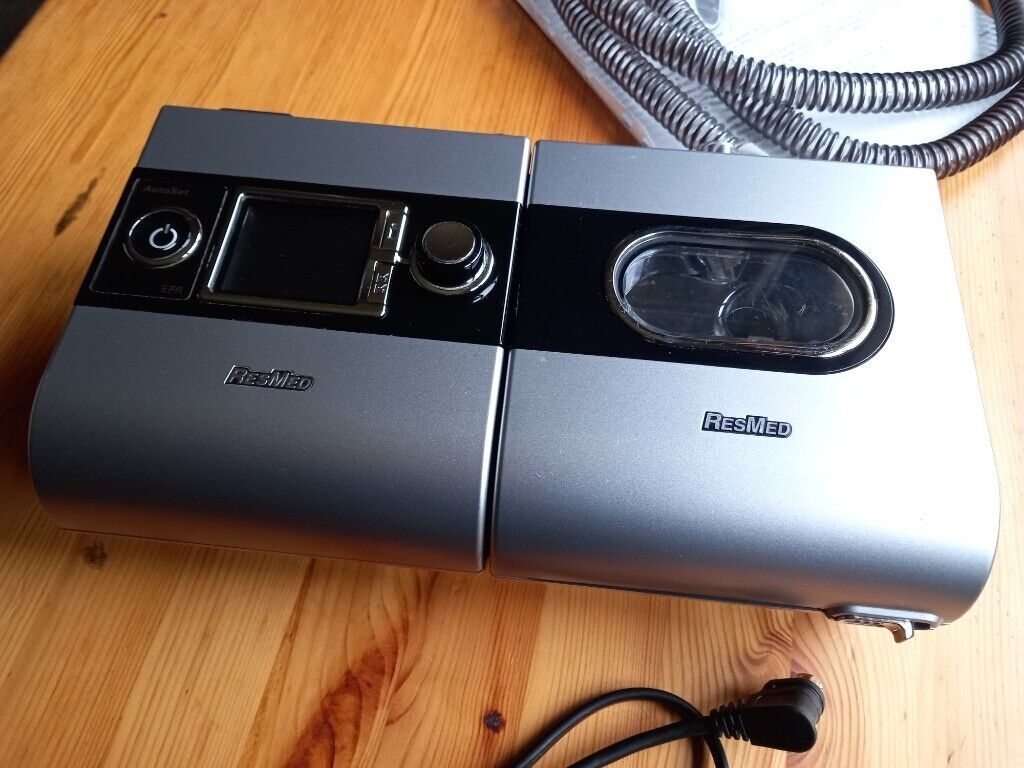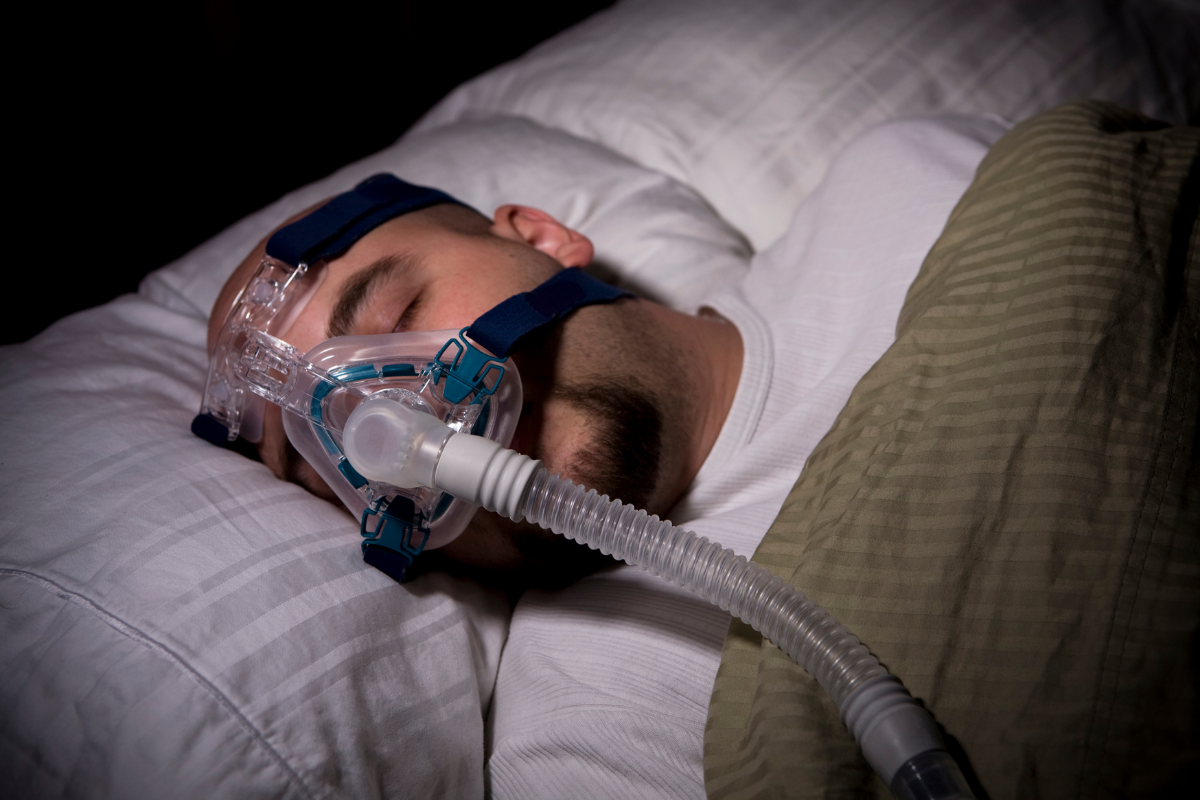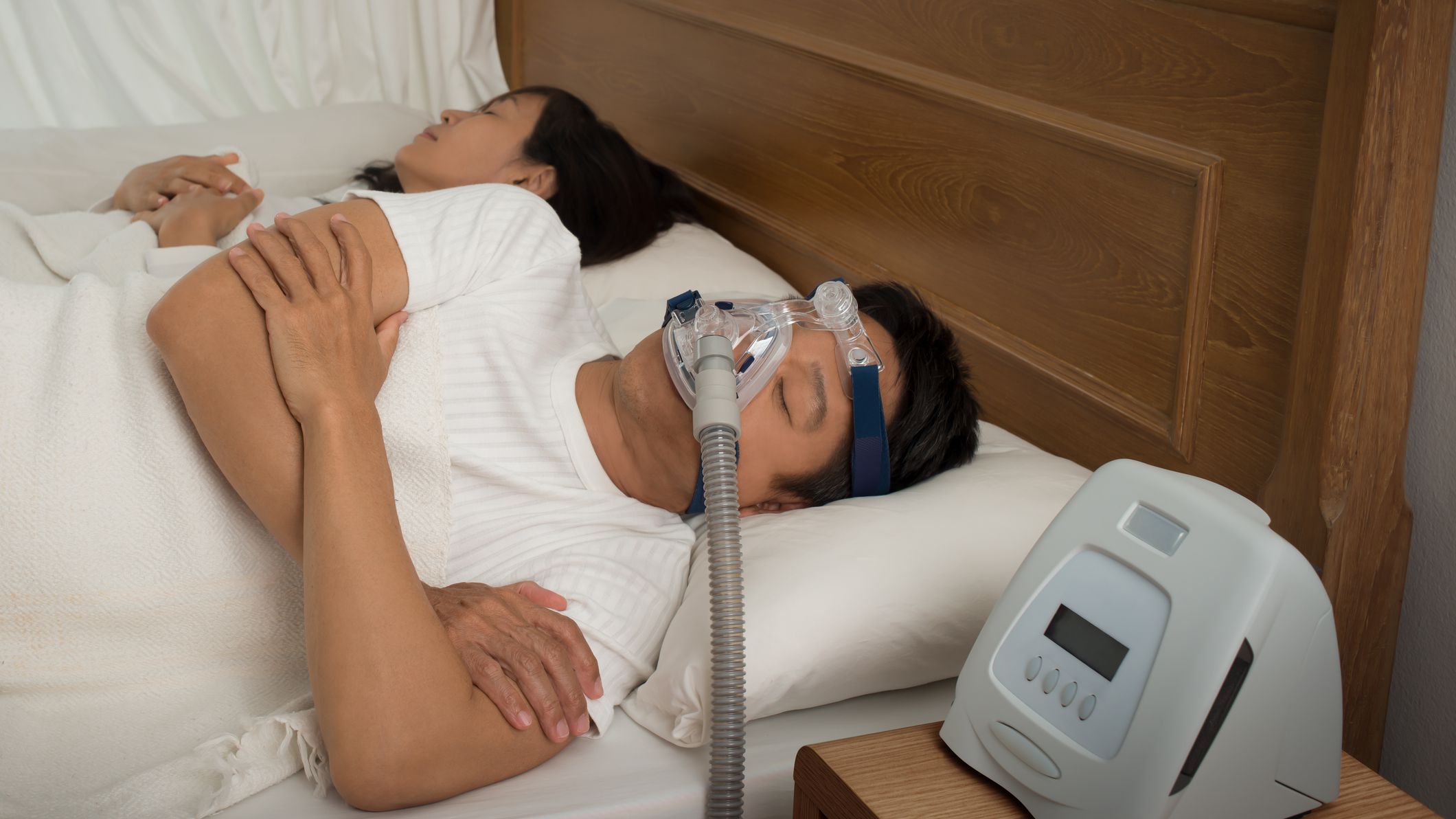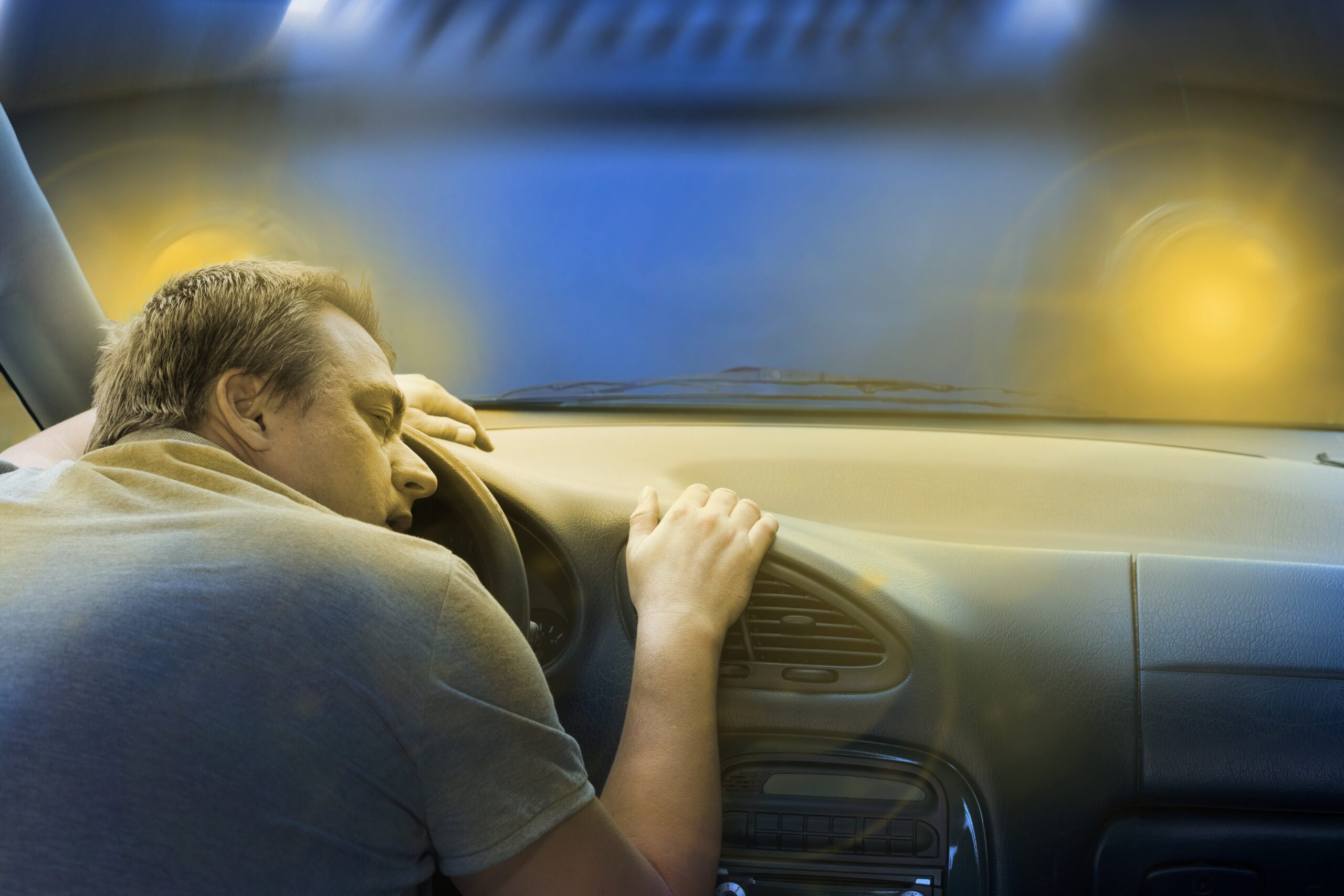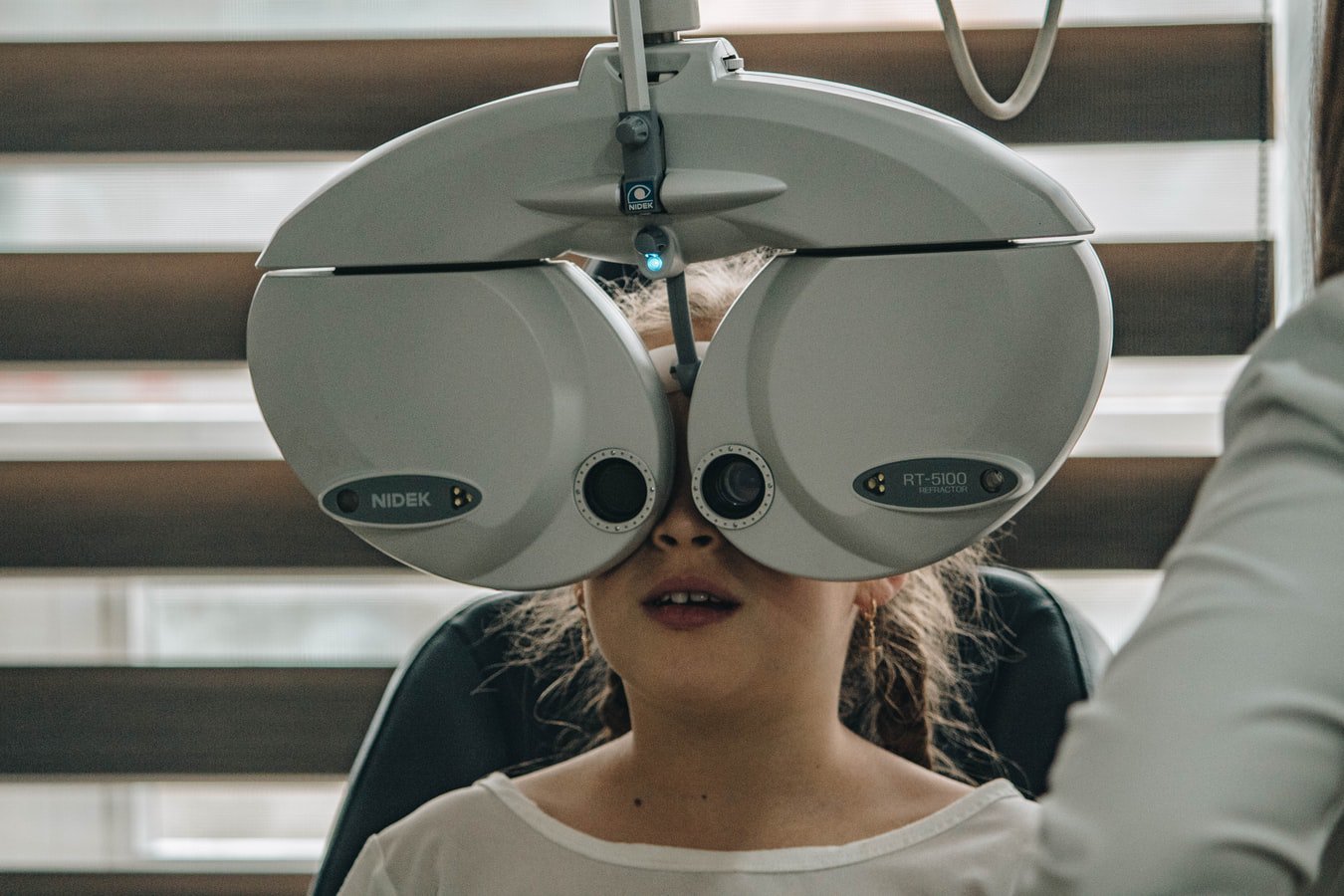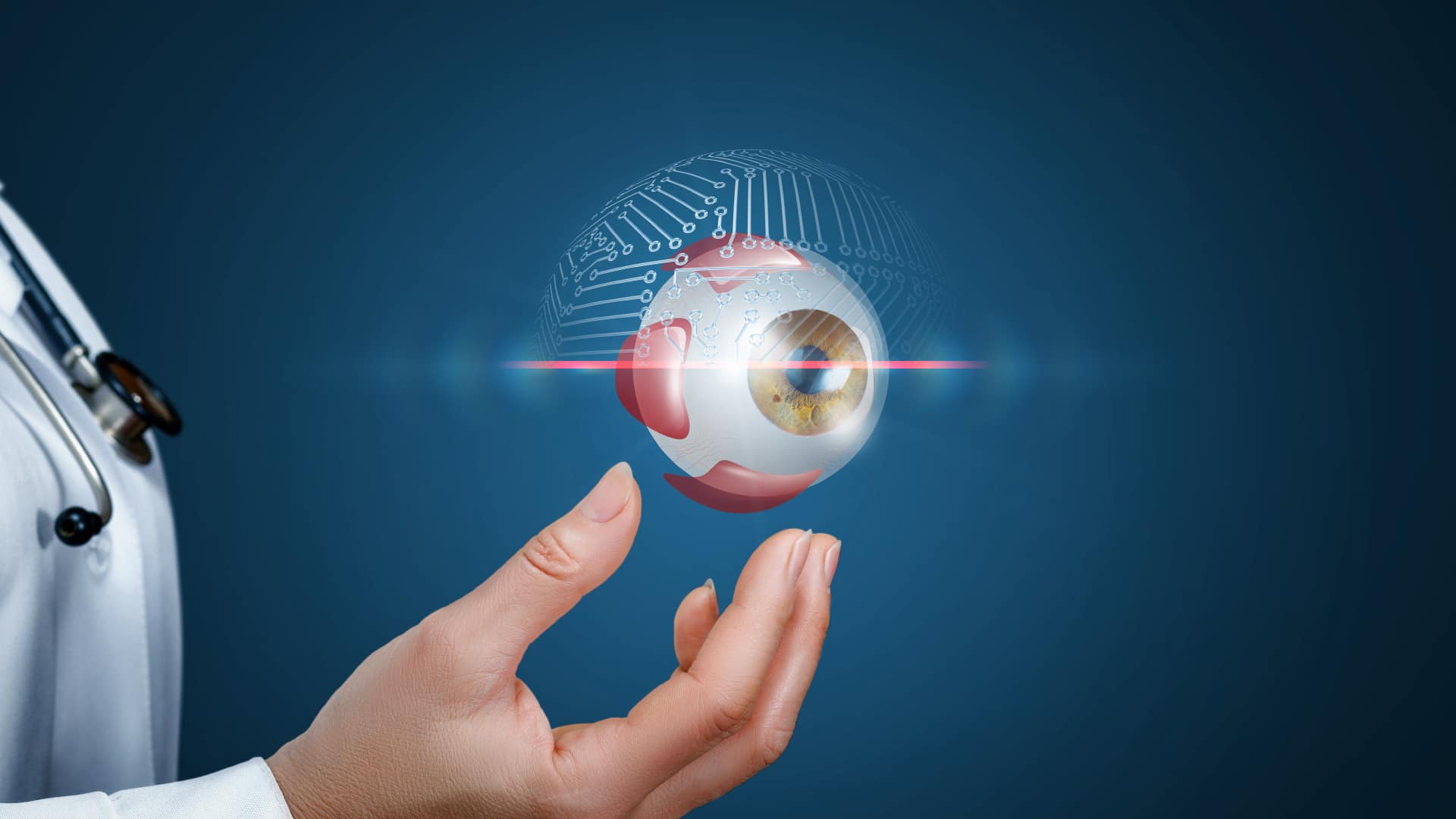Author: admin
The Best CPAP Machine and Accessories Cleaner Available
Anyone who has used a CPAP machine for more than a day has certainly wished there was a simpler method to clean the many parts and pieces that go along with it. Automatic CPAP cleaners claim to do this for you with the touch of a button; the question is, do they actually disinfect the device? In other words, will they make hand washing obsolete? In that case, does ozone or ultraviolet light fare better?
Today, we’ll discuss CPAP cleaners and address some of the most often asked concerns regarding them. If you think a CPAP cleaner may benefit your sleep hygiene, keep reading to learn more about the top models on the market.
Can I Get by Without a CPAP Cleaner?
Is a CPAP sanitizer essential? The answer may come as a surprise to you, so be ready: no. A CPAP cleaner isn’t compulsory. However, if you don’t clean cpap machines frequently, it can become a breeding ground for germs, mould, mildew, and other harmful pathogens. However, it is usually sufficient to clean with warm, soapy water on a regular basis to avoid the accumulation of germs.
People invest in CPAP sterilisers for a number of reasons. The majority of CPAP users don’t clean their machines as often as they should. We know how annoying it is to have to clean the mask cushion and tube every day. Even while ozone gas and UV light won’t get rid of oils, perspiration, makeup, and dead skin cells from your hands, a CPAP cleaning device can be a quick and easy solution to maintain your CPAP equipment sanitary in between hand washings.

We don’t want you to be one of the millions of CPAP users who don’t clean their machines as often as they should, but if that describes you, a CPAP sanitizer may be worth looking into.
Does Using a CPAP Sanitizer Reduce Germs?
Yes! These CPAP machines employ the same ultraviolet (UV) or ozone (O3) technology that is used to disinfect surfaces in numerous healthcare facilities, educational institutions, and food service establishments. Independent laboratory research has demonstrated that both UV and ozone are about 99.99% successful at eliminating potentially hazardous germs, and the FDA is actively collaborating with manufacturers to assess the efficacy of these devices.
- CPAP sterilisers that use ozone vs. those that use ultraviolet light
- Cleaners that use ozone to disinfect CPAP machines
Natural ozone, often known as O3 or activated oxygen, is a gas with a number of other names. The oxidation process causes the death of the microorganisms or germs from the inside out. In order to disinfect your CPAP equipment, ozone cleaners produce O3, which is then dispersed throughout your supplies via an internal fan or the blower from your CPAP machine. Most ozone sanitizers have a fresh air cycle and cartridge filters to decompose the ozone back into oxygen when the cleaning cycle is complete.
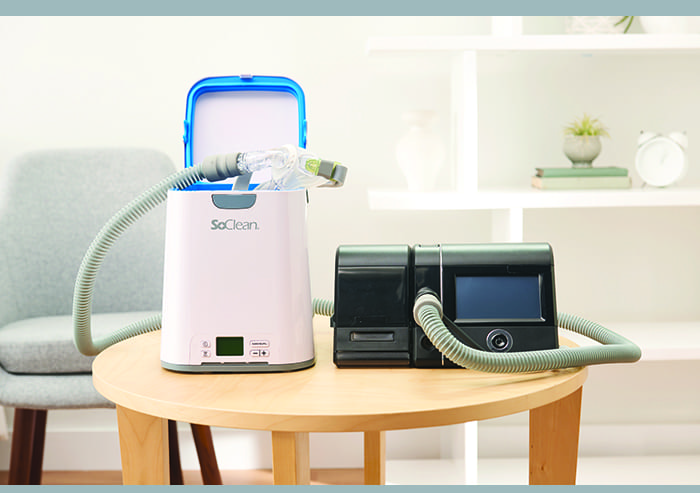
Advantage of Ozone CPAP Cleaners
- Ozone gas can penetrate parts of your CPAP machine that are inaccessible to UV light.
- You won’t need a separate adapter for your CPAP hose.
- The CPAP mask may be cleaned without taking apart any of its parts.
The Downside of Ozone CPAP Cleaners
Long waiting period after cleaning cycle. Because even a little amount of ozone used for disinfection can be dangerous, it’s crucial that you adhere to the manufacturer’s directions and give the cycle its full allotted time.
- Only use for cleaning CPAP equipment and accessories; not for general cleaning.
- Filter replacement and possible adapter needed.
Cleaners that use ultraviolet light for CPAP machines
The sun’s UV rays are well-known to the general public. To produce this high-energy UVB or UVC light that kills germs, UV cleaners employ specialised lamps or LEDs. The illumination from these gadgets is kept within their own housings, thus it has no effect outside of those areas.
Merits of UV CPAP Cleaners
Cleans CPAP equipment in minutes; sanitises other items like toothbrushes, dentures, jewellery, etc.; doesn’t need filters or adapters; and there’s no downtime thereafter.
Demerits of Using a UV CPAP Cleaner
- UV light can only clean what it can contact, and it cannot go into your CPAP equipment.
- You’ll need a separate tool to keep your CPAP tubing clean.
- Its cleaning chamber can only accommodate small items.
Here Are the Top CPAP Machine Washers
Today, there is a dizzying array of CPAP sanitizers vying for your business, making it difficult to zero down on the best option. To help you get the most value for your money, we’ve highlighted a few of our top picks, each of which combines cutting-edge technology with an affordable pricing.
The Paptizer by Liviliti is the most cutting-edge CPAP disinfectant available today.
Your CPAP mask, tubing, headgear, and humidifier water chamber will all fit comfortably within the Paptizer because it has the highest capacity of any UV sanitizer on the market. It has more LEDs than any other cleaner and can disinfect a whole room in only three minutes because to its 5-sided design.
There is no mercury in the LED bulbs, and the lights have a lifespan of 10,000 hours. Disinfects anything that fits within, has the largest internal capacity, and kills 99.99% of germs in three minutes. It also comes with a two-year warranty.

SoClean 3 is the most effective all-in-one ozone CPAP sanitizer.
If you use a cpap machine australia, you should upgrade to the SoClean 3, the latest and greatest version of the industry-leading cleaner. As opposed to other sanitizers, this one stays linked to your CPAP machine once you’ve set it up the first time. And because SoClean 3 is fully automated, you may set up a cleaning in the morning, and your CPAP supplies will be clean and ready to use before bedtime.
Highlights
Fully automated so you never have to remember to switch it on; sanitises your CPAP machine and supplies without taking your equipment apart; has a USB charging connector for your phone; has a 5-minute fresh air cycle; and requires no setup or disassembly.
The Lumin + Lumin Bullet from 3B is the Best UV CPAP Sanitizer Combo.
The Lumin CPAP sanitizer and the Lumin Bullet (both available for purchase separately) make for a potent duo. The key lies in the Bullet’s unparalleled capacity to clean the inside of your CPAP tube. The Lumin can be used to sterilise your mask, headgear, and CPAP accessories, while the Lumin Bullet makes use of magnets and an LED probe to reach places that standard UV sterilisers can’t.
Highlights
No filters or adapters are required, and the CPAP supplies may be sterilised in only 5 minutes with the Lumin. Additionally, the Lumin Bullet can sterilise the CPAP hose in as little as 2 minutes.
More to read: ResMed S9 Autoset CPAP Machine Review
… Read MoreResMed S9 Autoset CPAP Machine Review
Do you ever just suddenly wake up in the middle of the night gasping for air? Do you find that you are always exhausted during the day? Do you often wake up with headaches and have trouble falling or staying asleep?
All of these are indications that you may be suffering from obstructive sleep apnea, a disorder in which the muscles in your throat block your airway while you are sleeping, forcing you to breathe in short bursts. Having sleep apnea is not an easy condition to live with. It is also possible that it might have a role in the development of health problems such as high blood pressure, heart difficulties, and diabetes.
You will be relieved to know that treatment with Continuous Positive Airway Pressure (CPAP) can help you keep it at bay. Every night, it will help you breathe easier and get a better night’s sleep by blowing pressured air into your airway, preventing your throat from contracting and allowing you to breathe normally again. It even helps with snoring difficulties, which means that you will never again have to worry about waking up your sweetheart in the middle of the night!
See Also: The Best CPAP Machine and Accessories Cleaner Available
However, therapy with CPAP is not as straightforward as taking a tablet every day. If you want to be able to get a good night’s sleep despite using a CPAP machine, you need to look into your options. The ResMed S9 AutoSet CPAP Machine is only one example of the type of CPAP machine that has received several ecstatic reviews on the internet.
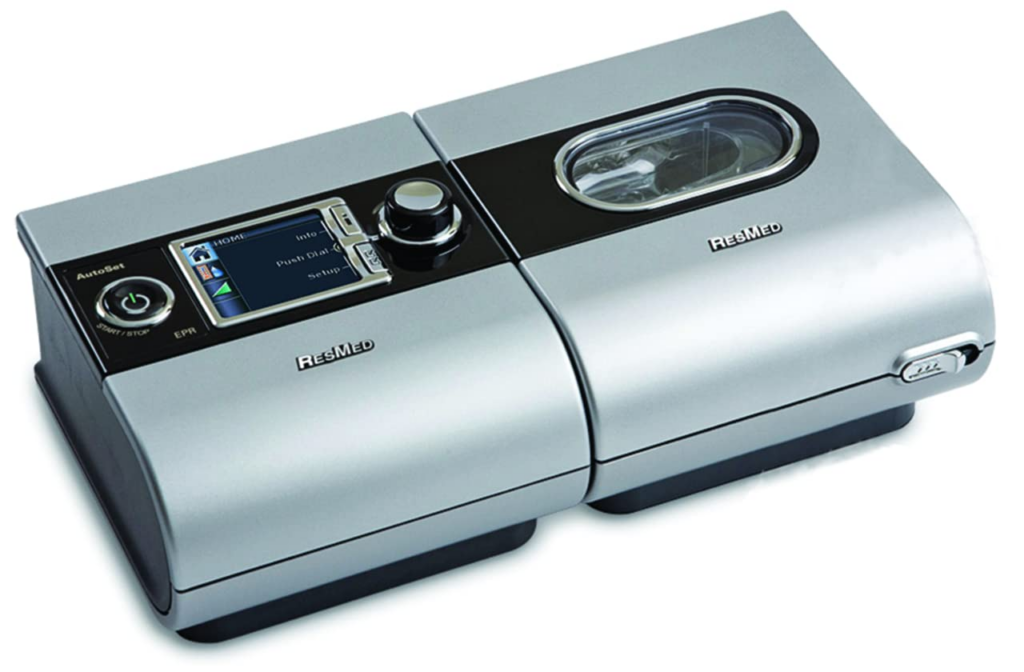
In this review, let us take a more in-depth look at a popular choice among the audience:
Overview
One of the most widely used continuous positive airway pressure (CPAP) machines available today is the ResMed S9, and for good reason. It has a low profile, is simple to operate, and comes highly recommended by both medical professionals and their patients.
In ResMed’s S9 series, the S9 AutoSet is the most advanced and comprehensive auto-adjusting device available. It is equipped with the Easy-Breathe technology, which enables you to maintain your natural breathing pattern even while using the CPAP mask.
This CPAP machine is backed by ResMed, one of the most reputable names in the business, and has a number of accessories and attachments that may all help you breathe easier while you sleep. ResMed is also one of the companies that invented the CPAP machine.
Principal Attributes
- Climate Control Heated Humidifier: The H5i Heated cpap Humidifier provides optimal relief from dryness and congestion by utilising clever humidity management technology. However, you should be aware that this attachment is not required to use your CPAP machine and may be purchased separately as an add-on accessory.
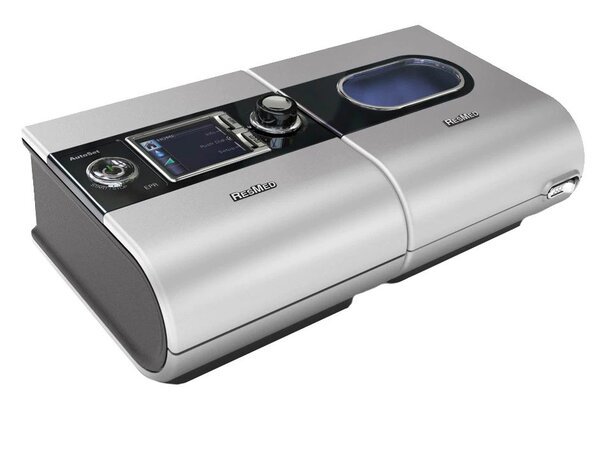
- Intuitive Interface: The gadget features a screen that is completely colourful and has controls that are simple to use. In addition to this, it is simple to set up as long as the directions in the manual are followed. The heated humidifier attachment of the CPAP machine may be removed quickly and conveniently for the purposes of cleaning and transporting the device.
- Smart Start / Smart Stop: ResMed’s Smart-Start and Smart-Stop technologies enable you to automatically start your machine by breathing into the mask. This saves you time and eliminates the need to manually turn it on. Taking off the mask will also result in the termination of your CPAP treatment.
- Mask-Fit System: The ResMed S9 AutoSet CPAP Machine features a Mask-Fit System, which enables the user to first evaluate the fit of the mask before using the device. Because of this, it is simple to determine whether or not there is a leak.
- Easy-Breathe Technology: The ResMed S9 AutoSet automatically changes the pressure so that it only gives the exact amount of pressure that is necessary from breath to breath. This technology is part of ResMed’s Easy-Breathe Technology. Because to this technology, you will be able to breathe through the mask in a manner that is completely natural and unrestricted, just as if you were not utilising a CPAP or VPAP machine at all. There is no need for controllers or switches, both of which may be easy to lose track of.
- SlimLine Tubing: The reduced circumference of the SlimLine tubing helps reduce the amount of drag that is exerted by your mask, which in turn improves the overall fit of the mask and the level of comfort experienced when sleeping.
- Advanced Data Reporting Directly on the Display: On the device itself, the ResMed S9 AutoSet displays an overview of your current sleep apnea treatment settings. The data that was collected includes things like the typical amount of time utilised, the number of hours used, the number of days used, the run hours, and the pressure.
The Pros and Cons of the ResMed S9 AutoSet CPAP Machine
The Positives: The ResMed S9 AutoSet CPAP machine technology adjusts itself breath by breath, just as the needs arises; it is noiseless; the ResMed S9 auto-set CPAP machine has an intuitive design and user-friendly controls which makes it easier for patients to operate and get along with; the ResMed S9 auto-set CPAP machine also has been highly rated by both medical professionals and patients because of its awesome user experience. The machine is very comfortable to use, and it comes with an optional humidifier connection, and with optional heated tubing.
The Negatives: because of the amazing features of the ResMed S9 auto-set CPAP machine, it can become costly for many people to afford, especially if you’re paying for it from your own pocket. If it is not covered by Medicare, it can be out of budget for many people.
At Air Liquide Healthcare, we provide amazing CPAP machine and accessories options for people to treat their sleep apnea condition, if you want more clarity and professional advice about this condition, you should book a consultation session with our sleep specialist today!
… Read MoreCPAP Machine and Sinus Infection
The most effective treatment for OSA is continuous positive airway pressure therapy. Those with OSA can’t live without CPAP, but the therapy isn’t always adhered to because of common adverse effects like dry eyes, face discomfort, and headaches. One prevalent worry with CPAP machines is the risk of sinus infections, especially for people who suffer from seasonal or chronic allergies.
Fortunately, we did not find that CPAP machines actually increased the risk for sinus infections so long as you maintained a regular cleaning regimen. The best defense against a sinus infection caused by CPAP is regular maintenance, including changing or cleaning the air filter (depending on whether your machine utilizes reusable or disposable filters), rinsing and disinfecting the CPAP hose, and emptying the humidifier chamber.
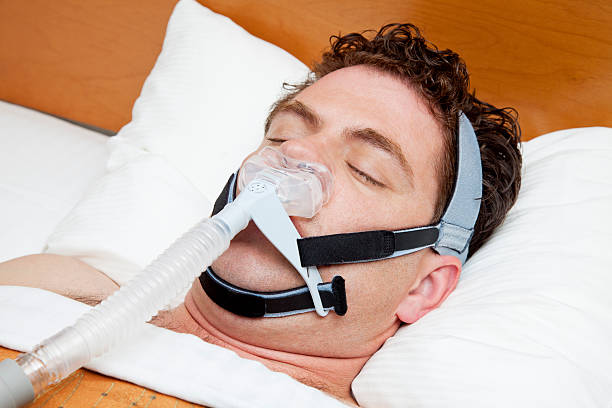
Keep reading and we’ll explain everything you need to know about CPAP machine-caused sinus infections and how to avoid getting them in the first place, including what causes them and what you can do about it.
Does Using a CPAP machine Cause Sinus Infection?
Without further humidification, CPAP therapy naturally dries the airway and forces filtered air from the surrounding environment into the lungs. A CPAP machine that is not regularly cleaned can become a breeding ground for bacteria, although the therapy itself is not linked to an increased risk of sinus infections. Click here to read about 6 home remedies for obstructive sleep apnea.
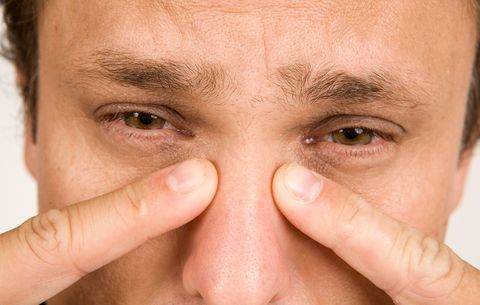
Two studies, one from 2012 and another from 2016, support the idea that OSA patients frequently have nasal inflammation and sinus infections. Those with OSA were found to be 3.18 times more likely than those without OSA to develop chronic rhinosinusitis.
However, the data also revealed that CPAP users had increased resistance to bacterial invasion of their disease-fighting white blood cells. Because this tolerance was not observed in non-CPAP therapy patients, we can infer that CPAP therapy reduces the risk of sinus infections rather than exacerbates existing ones.
Further, a 2017 study found that CPAP users did not have more sinus infections than non-CPAP users. It also discovered that the mask, machine, and humidifier you use make no appreciable difference in the frequency with which you have sinus infections. Visit http://mhsblogs.com/what-does-a-high-cpap-ahi-mean/ to read about What Does a High CPAP AHI Mean?
Poor maintenance and improper usage of a CPAP machine can lead to airway irritation and sinus infections, but the equipment itself does not cause these conditions. As a result, using CPAP while neglecting to keep the device clean is the only way to get a sinus infection.
In addition, if the device’s tubing or mask isn’t cleaned regularly, bacteria and other germs can begin to multiply there. Mold and fungi can grow in the humidifier, increasing the likelihood of a CPAP-related sinus infection.
Preventing Sinus Infections While Using CPAP Machine
The best way to avoid CPAP sinus problems is to maintain your CPAP machine regularly. The following is a list of things you can do to reduce your risk of developing a sinus infection due to using a CPAP machine:
Always change the air filters and clean your CPAP machine.
The importance of keeping CPAP equipment clean cannot be overstated, especially if you suffer from seasonal or chronic allergy issues. Your CPAP mask and cushion/nasal cushions should be washed daily in warm water with mild soap as soon as you get out of bed.
The humidifier tank needs to be emptied and dried, and the line needs to be hung up to air dry. Humidifier tanks and hoses should be washed out with soap and water once a week.
If your machine has a disposable air filter, you should change it at least once a month to keep it functioning properly. A reusable filter in your machine should be cleaned once a week and swapped once every six months.
The danger of illness from fungi, mildew, and bacteria can be reduced by using a specialized CPAP cleaner, which should be used in addition to, rather than in place of, your regular cleaning routine.
Use Distilled Water
To avoid unpleasant side effects like a dry mouth, stuffy nose, or nosebleeds, heated humidification is essential. While some microorganisms, like yeast and mold, flourish in warm and damp conditions, it is possible that your community’s water supply is tainted.
Using distilled water in a humidifier is a good way to avoid getting sick from mold or mildew. Distilled CPAP water not only protects your machine from mineral buildup caused by tap water, but it also decreases the likelihood of amoeba infections.
Adjust Your Humidifier and Consider Using a Heated Hose
The 2017 study we cited earlier revealed that heated humidification with CPAP did not reduce the occurrence of sinus infections, albeit it did help alleviate symptoms related to airway dryness. However, using a humidifier does include the risk of the hose being clogged with condensation. If you run a humidifier for an extended period of time without letting the hose drain thoroughly each morning, you may be encouraging the formation of mold and mildew.
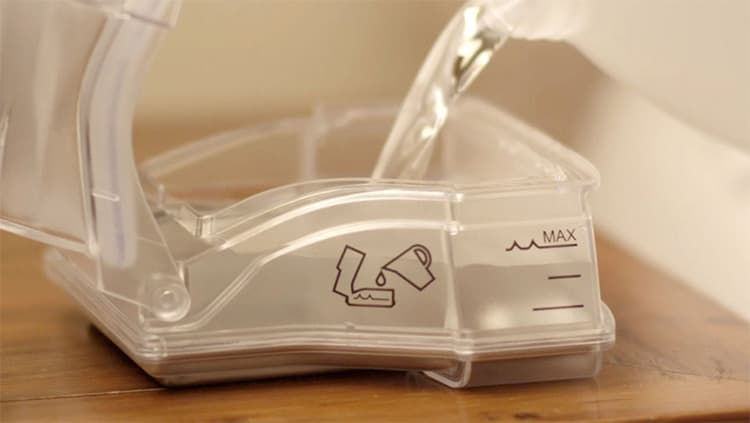
However, you shouldn’t necessarily continue to use humidification, as low humidity levels can potentially cause issues like mucosal dryness. Humidified therapy air can be delivered to you more comfortably with the help of heated hoses, which keep the hose at a constant temperature all the way through. This helps keep the CPAP experience similar throughout the year by minimizing condensation buildup.
Do not Give Out your CPAP Machine or Mask to People to Use When ill
It goes without saying that you shouldn’t reuse anyone else’s mask, cushion, or tube, not even your partner or a member of your own family. You should also take extra precautions to disinfect your equipment before, during, and after exposure to an infectious illness. If you’re sick with a cold or the flu, it’s important to keep your mask and tubing clean so that you don’t get sick all over again.
Should I Stop Using CPAP When I Have a Sinus Infection?
In general, you should keep using your CPAP machine even if you’re feeling under the weather. Using your humidifier and ramp feature may help you manage the pressure when unwell, and the disadvantages of untreated sleep apnea will not aid in your recovery. If you frequently use a nasal mask for your treatment, you may find that having a full-face mask on hand for these situations is helpful in alleviating the discomfort associated with the nasal irritation.
… Read MoreGuide on How to Set Up Your CPAP Pressure Correctly
In order to give the most recent valid information, Air Liquide Healthcare routinely compares the information included within our pages to that found in the most recent scientific publications and most highly recommended websites, and other resources.
Those who suffer from obstructive sleep apnea (OSA) have difficulty breathing for brief periods while they sleep as a result of their airways being obstructed or collapsing. After a sleep apnea test, doctors will often recommend using CPAP Masks to treat the issue. The gadgets assist normalise breathing by delivering pressured air. Too little or too much pressure can have unfavorable consequences on CPAP therapy, so getting it just right is essential.
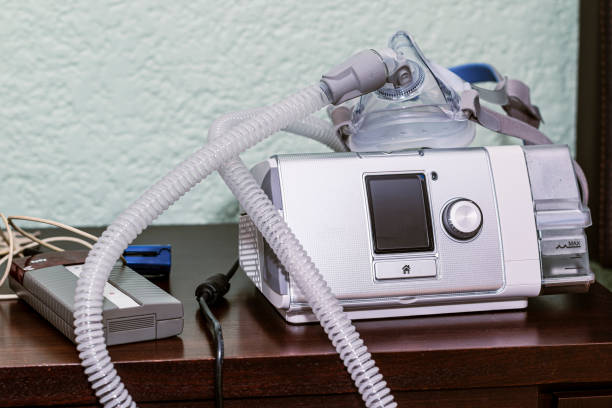
We’ll go over the several variables that go into establishing a comfortable CPAP pressure level. We’ll point out warning indicators that should prompt you to visit your doctor and request a blood pressure adjustment. Only a medical specialist should adjust the pressure settings.
Adjusting Your CPAP’s Pressure
A CPAP Machine’s output pressure is expressed in centimeters of water pressure (cm H2O). Device-specific, the typical pressure range for CPAP devices is between 4 and 20 cm H2O. Though uncommon, there are devices that can pump up to 30 cm H2O. People with OSA typically have a pressure setting1 of around 10 cm H2O.
The most typical approach to settling on a suitable pressure out from your CPAP mask is a titration study. The evaluation takes place over the course of one night, just like a sleep study would. Your oxygen levels, respiration, heart rate, brain waves, and mobility are all tracked by sensors that are strapped to your person. A doctor or sleep expert will adjust the CPAP pressure until the minimum level necessary to maintain open airways is reached.
The number of times a person stops breathing or breathes shallowly when asleep is measured by the apnea-hypopnea index (AHI), which is used to guide the adjustment of CPAP pressure by doctors. The AHI is tracked by most current CPAP devices, so you and your doctor can easily see whether your pressure needs to be adjusted.
Essential to the success of your therapy, you will be equipped for a CPAP mask during the trial. Full-face masks, nasal masks, and nasal pillows are just some of the CPAP mask options out now. After the research is complete, you and your doctor may talk about the best CPAP pressure setting for you. Depending on the findings, they may also suggest adjustments to your CPAP routine. You can also read about CPAP Machine and Sinus Infection by visiting http://mhsblogs.com/cpap-machine-and-sinus-infection/
Adjusting the Pressure on a CPAP Mask: Some Considerations
The severity of OSA and the required CPAP pressure for an individual depend on a number of factors. Some are inherent to the human body, while others are the result of behaviours like eating late at night or not getting enough shut-eye.
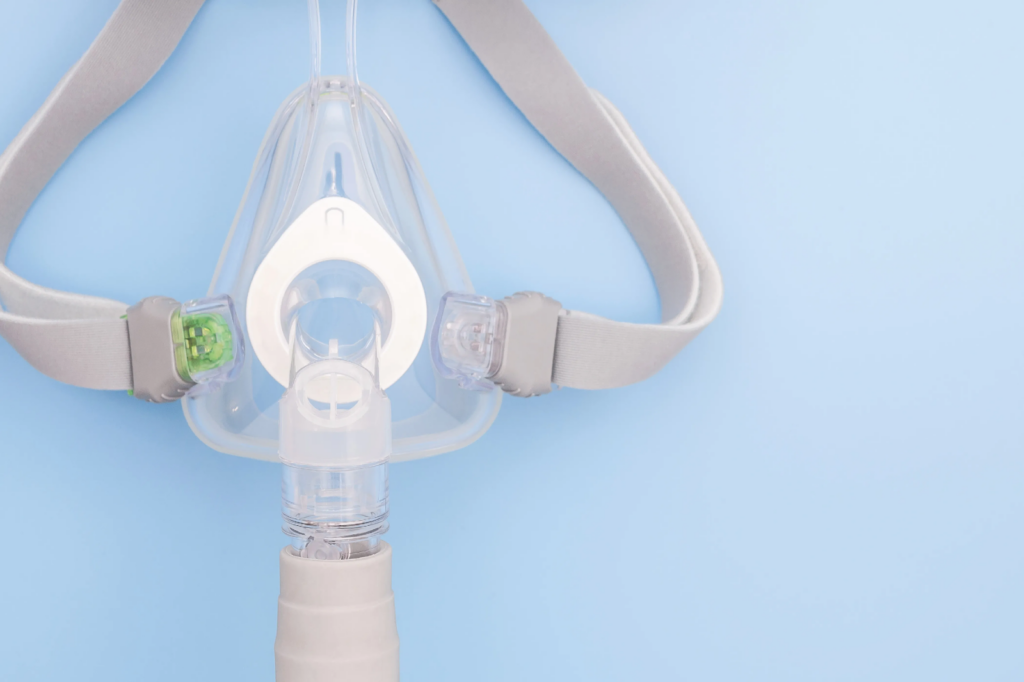
People with craniofacial or upper airway anomalies, such as a tiny lower jaw, a big tongue or tonsils, or a neck circumference of more than 17 inches, may be more susceptible to developing OSA and may require higher CPAP pressure settings. Click here to read about CPAP pressure and flow data at 2 positive pressure levels and multiple controlled breathing rates from a trial of 30 adults.
A deviated septum restricts nasal airflow, which may need a greater amount of pressure to maintain an open airway in the head and neck.
Extra tissue in the neck of obese persons is associated with decreased airflow to the lungs, hence BMI is an important factor to consider. When a person loses a large amount of weight, they often need to reduce their pressure setting because pressure needs tend to grow with a person’s weight.
Nasal allergies: Allergies and nasal congestion may impede breathing, leading to lower oxygen levels. A CPAP Mask equipped with a humidifier may be useful for those with allergies, in addition to the pressure settings calibration. Filters may also be kept free of allergens by being cleaned regularly.
Sleeping on one’s back is thought to be the worst posture for sleep apnea6 because the body’s weight presses down on the trachea and esophagus. As a result, those who sleep on their backs typically need greater pressure settings. Because it relieves pressure on the upper airways, side sleeping7 is recommended for persons with OSA.
Adjusting CPAP Mask pressure and its advantages
Conditions related to sleep apnea, such as snoring and sleep disruptions, can be alleviated with the right CPAP pressure settings. Your doctor may recommend a change in your CPAP pressure settings if you find that you are still having trouble sleeping while using the device. Here are some warning signals of low or high blood pressure:
Too Little Pressure: If you use a CPAP Mask but still feel tired or unrefreshed in the morning, your airways may not be getting enough oxygen. When your CPAP pressure is too low, you may have side effects like as heavy snoring, a choking sensation, or no reduction in hypertension. However, if your AHI does not start decreasing once you have included CPAP therapy in your regular sleep regimen, it may be time to try a different setting.
Too much pressure coming from your CPAP Mask. When you start to feel uncomfortable, you know the pressure is too much. Symptoms of high pressure include difficulty breathing, dryness of the mouth and nose, and a burning sensation in the throat. Others have issues with mask leaks, fluid in the ears, and wind or belching after ingesting air.
Masks that Use the APAP Algorithm
Your doctor may recommend an automated positive airway pressure (APAP) machine if you continue to struggle with the pressure settings on your current equipment. The user’s breathing patterns are detected and used to regulate the device’s pressure. A patient’s respiration and airway resistance are monitored and the Mask’s intensity is adjusted accordingly.
A doctor will still need to recommend a specific pressure range that works best for you, despite the fact that APAP Masks can regulate the pressure on their own. Some unwanted consequences may manifest themselves if the range is incorrect.
… Read MoreWhat Does a High CPAP AHI Mean?
Users of continuous positive airway pressure (CPAP) devices and apps often report feeling confused by the data they are presented with. The AHI is one such, if not the most significant measures that your CPAP machine records. In this article, we’ll discuss how to evaluate your AHI and what steps you may take to bring it down if necessary.
In CPAP terms, what does an AHI mean?
Apnea-hypopnea index is the abbreviation for this measurement. Sleep studies are the gold standard for estimating AHI. The word REI (respiratory event index) may be used instead of AHI in a home sleep apnea test result.
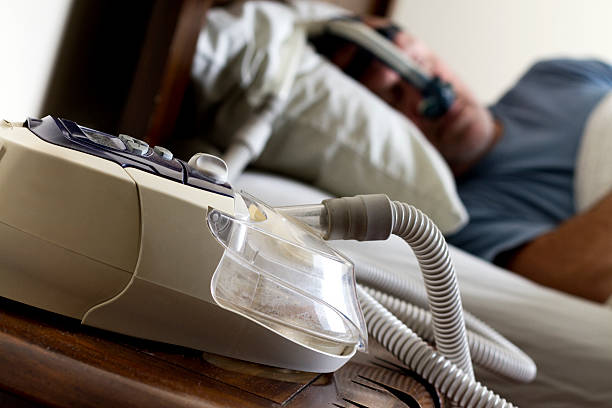
When you remove your CPAP mask in the morning, many devices may display information about your use the night before, including your AHI. To differentiate this value from the AHI that is determined by the gold standard, a sleep study, I prefer to call it the “calculated AHI” or cAHI.
With the use of a CPAP machine’s smartphone app, you may collect and analyze more data over time. You need to connect your CPAP machines to a clinical database in order to get the full range of available information. The AHI is broken down into snoring, central apneas, obstructive apneas, and hypopneas, which I, as a sleep physician, can access.
CPAP: what’s a decent AHI?
In most cases, the cAHI should be set at or below 5, as this value indicates the absence of sleep apnea as determined by a sleep study. From what I’ve seen, a cAHI of 5 or less is considered good, but a cAHI of 3 or less indicates that your sleep apnea is under excellent control. Please be aware that I have never encountered a zero AHI. No matter how well you program your system, it will always estimate a small number of breathing occurrences as a residual.
“Treat the patient, not the numbers” is a common medical maxim. Nighttime oxygen level studies are frequently checked if an AHI is high despite the patient’s report of good sleep and general well-being during the day. I will not adjust the CPAP settings if oxygen levels are within normal range. You can read about CPAP and Bi-level PAP Therapy: New and Established Roles by clicking here.
Ways the CPAP machine reports the AHI
An AHI estimate is calculated by CPAP devices using proprietary algorithms. We sleep doctors think the gadget “pings” your airway with little bursts of air to test if it is open, measuring resistance to the airflow they are trying to provide.
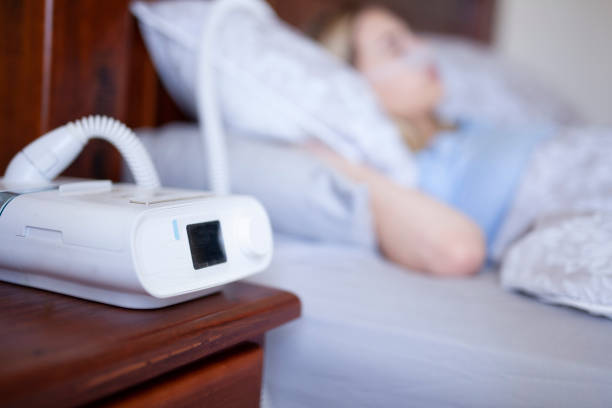
For example, a CPAP machine will “ping” your airway if it detects a lack of airflow for more than 10 seconds. An obstructive apnea is detected if the air packet is reflected back to the monitor, indicating that the airway was blocked. If the air packet doesn’t come back, it indicates that your airway was clean and that this apnea was central. Hypopneas are thought to occur when there is a sudden and dramatic increase in resistance to the airflow given by the CPAP for at least 10 seconds.
Keep in mind that the cAHI should be viewed with caution because CPAP devices do not conduct diagnostic sleep studies on you on a nightly basis. Visit http://mhsblogs.com/guide-on-how-to-set-up-your-cpap-pressure-correctly/ to read about the Guide on How to Set Up Your CPAP Pressure Correctly.
Is the CPAP AHI reliably accurate?
Not at all true. Keep in mind that the cAHI can provide you a very accurate picture of how well you’re performing overall. Moreover, it is essential to examine the data patterns, rather than relying on a single night’s worth of information, before drawing any judgments. Mask seal, alcohol consumption, drugs, body posture, altitude, and other variables can all affect AHI from one night to the next. Before evaluating whether or not a CPAP machine has to be changed based on the cAHI, we want to gather at least two weeks of continuous data.
By and large, we have found that the AHI from a sleep study done on the same patient while they were using CPAP is much greater than the cAHI from the CPAP machine. The cAHI may be grossly underestimating the true incidence of residual abnormal breathing occurrences, as we believe it does.
The cAHI can give you a ballpark figure for how many residual abnormal breathing episodes you’re averaging each hour, but it shouldn’t be seen as gospel.
How can a CPAP’s AHI be reduced?
To put it simply, high leak is the most prevalent cause of a high cAHI. Your airway will continue to collapse if air is exiting from the system rather than entering your throat. When a leak occurs, it might be one of two types: the mouth leak and the mask leak.
The most prevalent sign of a leaking mouth is a persistently dry mouth when you wake up. Wearing a full-face mask or chin strap if you’re experiencing this is highly recommended.
If your CPAP mask is leaking, you need to replace it. Those who use CPAP and sleep on their side may also require a certain type of pillow.
Complex sleep apnea, in which you have obstructive sleep apnea before starting CPAP, can also lead to a high CPAP AHI.
With this issue, there may be a need for you to adjust the pressure in your machine. Among the many possible ways to this are:
The pressure reading from your machine may be inaccurate for you due to a number of reasons, including but not limited to: your body weight; some kind medical conditions that might exacerbate sleep apnea, such as hypothyroidism, PCOS, atrial fibrillation, heart attacks, and strokes; New drugs that can impact muscle tone or the diameter of your airway, such as testosterone;
If your AHIs have been consistently high and the cause does not appear to be a leak, you should consult a sleep specialist.
… Read MoreHow often should you visit a Sydney eye clinic
Your age, as well as your eyes, family, and other factors, have a role.
Your doctor could advise regular Sydney eye clinic exams every two years if you’re under 40 and don’t have any eye issues. Or they could inform you that no tests are necessary. Find out their recommendations for you.
Every 1-2 years, everyone 40 years of age or older should get their eyes examined.
You should visit Sydney eye clinic annually if you’ve ever had eye problems or if you’re at risk of doing so (for example, if someone in your family has).
Why? You should get your eyesight checked to discover whether you have any major, often “silent” issues like glaucoma, age-related macular degeneration, cataracts, or diabetic retinopathy.
When your kid is a newborn and again at each routine medical checkup, if they don’t have any risk factors for eye issues, their eyesight should be assessed. It will be simpler for the doctor to evaluate their eyes when kids are 3 years old. Every one to two years after the first grade, kids should get their eyes checked.

Are My Eyes in Danger?
You may need more regular tests if you have a health issue like high blood pressure, perform a profession that demands a lot of eye contact, or use medications that might impair vision.
Get your eyes tested if you have type 1 diabetes within five years of your diagnosis and then annually after that.
If you’re told you have type 2 diabetes, you should be checked out right away. After that, get your eyes tested annually.
How to Get Ready
Mention any visual issues you may have when you call to schedule your test.
Make a note of any questions you have for the doctor before you visit. Be prepared to give them an update on any medications you use as well as your (and your family’s) history of eye health.
Bring the prescription, your glasses, and your contact lenses. Bring sunglasses as well for the return journey. To dilate your pupils, the doctor could use eye drops. It is known as dilation. After that, light sensitivity will affect your eyes.
When You Get a Sydney Eye Clinic Exam
The eye doctor or a member of the office staff will first inquire about your past medical and visual history.
Depending on the technology utilized, the test might run anywhere from 30 minutes to several hours. It will cover your eye health and eyesight.
The majority of the following Sydney eye clinic exams, as well as maybe a few more, will likely be performed on you:
Test of eye muscle movement: This determines the alignment of your eyes. The physician will observe how your eyes move while you track a moving object (such as a finger tip or their pen) as it changes direction.
The cover test reveals how effectively your eyes cooperate. You’ll fix your gaze on a little object in the distance. To measure how much your eyes move, the doctor will cover and uncover each eye. Additionally, your doctor will be looking for an eye that shifts away from the intended target. Strabismus is the medical term for this issue. You are welcome to retake the Sydney eye clinic exam with a nearby target.

External examination and student responses
The doctor will observe how your pupils respond to light and nearby objects. Your eyelids’ posture and the whites of your eyes will also be examined at the same time.
You’ll sit in front of an eye chart with progressively smaller letters as you read down each line to undergo a visual acuity test. You’ll cover each eye in turn and read aloud while moving down the chart while using the other eye until you can no longer make out the letters.
Refraction testing: The doctor might use a computerized refractor to determine your precise lens prescription. By switching the phoropter back and forth between lenses and asking you which is better, your doctor will adjust the prescription. You won’t need this Sydney eye clinic exam if you don’t need corrective glasses.
The slit lamp (biomicroscope) enlarges and illuminates the front of your eye. In order to search for indications of certain eye disorders, the doctor utilizes it to examine your cornea, iris, lens, and back of your eye.
The retina, retinal blood vessels, fluid in your eyes (which your doctor may refer to as vitreous fluid), and the head of your optic nerve may all be seen during a retinal examination (also known as an ophthalmoscopy).
Tests for glaucoma determine if the fluid pressure within your eyes is within a normal range. It is quick, painless, and there are a few methods to accomplish it:
The most precise device is the tonometer. You’ll be given eye drops to numb them. To measure the pressure, the doctor will instruct you to look straight ahead as he or she lightly touches the front surface of each eye using an instrument known as an applanation tonometer or Tonopen.

Noncontact tonometer or puff of air: As you look at a target, a machine will blow a little puff of air into each of your eyes. Your eye’s resistance to the puff reveals how much pressure is there there.
Pachymetry: In this Sydney eye clinic examination, the thickness of your cornea is measured using ultrasound. False low-pressure readings may be the result of thin corneas. False high-pressure readings may result from thick corneas. One test may be administered to you in order to establish a baseline for comparison with subsequent results. People who need corneal surgery may utilize it.
Pupil enlargement: The doctor will use instruments and lighting to examine the inside of your eyes after thoroughly enlarging your pupils. It takes the eye drops for this portion of the test 20 to 30 minutes to start working. They obstruct your eyesight and increase your eyes’ sensitivity to light. These effects might linger for many hours or more. You may need those sunglasses on the way home because of this. Modern devices can see the very back of your retina without dilation of your pupils.
Perimetry of the visual field: Your visual field is the region in front of you that you can see clearly without shifting your eyes. Your Sydney eye clinic doctor will map what you see at the edges (periphery) of your visual field using one of three tests and utilize this map to identify any eye issues.
4 ways to find a Sydney eye clinic
1. Request referrals from relatives or friends.
2. Seek advice from your primary care physician.
3. Contact a neighboring hospital’s ophthalmology or optometry department and inquire about the physicians that work there.
4. Speak with local and state organizations, associations, and academies of ophthalmologists and optometrists to see if they can assist you.
… Read MoreHandy question tips that help during Sydney eye clinic appointments
What questions are you asking your Sydney eye clinic patients? By spending four minutes asking these eight questions, you can significantly increase both your capture rate and your second pair sales.
Who knows, you may even uncover additional medical conditions as well!
- Please describe what you currently wear?
This simple question helps determine what the patient is wearing, and just as important, what they are not wearing. It is a good ice breaker question. It also gives the Sydney eye clinic direction about other visual options that the patient needs such as sun wear, occupational wear or contact lenses. - Describe what you dislike about your current visual solution?
This question is built to determine where to focus, and which areas you need to fix or alter. For example, a patient may report glare at night, giving you a great reason to prescribe new visual solutions. - Do you have any special vision needs for your hobbies or occupation? Please describe. This opens the door for a conversation about second or third pairs of eyewear.
- Do you suffer from any of the following? Eyestrain, dry or irritated eyes, itchy eyes, fluctuating vision, headache, or red eyes.
This question is to pull out visual issues that many people do not associate with allergies, dry eyes, accommodative issues, or convergence issues. - How many hours a day/night do you use a computer?
The goal of this question is to determine the patient’s near point needs and the potential need for occupational eyewear. - Do you have trouble focusing in the distance after reading or using the computer for more than 10 minutes?
This helps identify accommodative or early presbyopia problems. - Do you have trouble reading street signs or with seeing glare from oncoming headlights at night?
We are looking for glare issues and the ability to sell anti-glare solutions. - Will you be purchasing eye wear, sun wear or contact lenses today?
Use this as your final question. If the answer is “yes,” it will be an easy sale. If the patient says, “maybe,” you need to look for prescription changes.

Preparing ahead of time can help you best manage your vision health. Here are some questions you can take along when you visit a Sydney eye clinic.
- What tests will we be doing today, and do they include a dilated Sydney eye clinic exam to check for diseases such as glaucoma and macular degeneration?
- Is there anything about my medical or family history that puts me at higher risk for eye disease?
- Are there symptoms to watch for and ways to monitor my eye health?
- How often do you recommend I return for a comprehensive Sydney eye clinic exam?
- Are there lifestyle changes that might lower my risk?
Things to bring to your appointment:
- Your health insurance information and a photo ID
- Eyeglasses or contact lenses you currently wear
- Information on any history of eye disease in your family
- A list of your medications, allergies, and other conditions
- A notepad and pen, or digital device, to take notes
- A friend or relative to accompany you if possible
If You are Diagnosed with an Eye Disease
Take an active role in the understanding and treatment of your condition. Here are some questions to ask your Sydney eye clinic when you discuss your diagnosis.
- Am I likely to need medications or surgery, now or in the future?
- Do these medications have any side effects?
- Will insurance cover these treatments, or is financial assistance available?
- What symptoms should I watch for, and do I need to contact you about any right away?
- Should I be concerned about driving?
- How often will you check my eyes to make sure they are not getting worse?
- Could I benefit from low vision services–such as occupational therapy or technological aids–to help me use my remaining vision?
- Do you have any materials or other suggestions on how I can learn more about this disease?

Additional questions to ask
1. Which Tests Will Be Performed?
Knowing what your eye doctor will do will put your mind at ease if you have any anxiety before your next Sydney eye clinic exam. You’ll also feel more comfortable.
Find out any instruments they will use to perform tests. You should also find out why specific tests are being conducted.
Do not hesitate to ask about the potential health risks and side effects of the tests. For instance, by knowing that a particular test will interfere with your vision, you can arrange for someone to drive you home after your appointment.
It never hurts to be well-informed and prepared, especially when it comes to your vision!
2. What Do My Results Mean?
The ophthalmologist will pick tests to give insights into your vision based on your eye issues or symptoms. Once the results are out, find out from your eye doctor what the results mean.
When you have your results, you can discuss any next steps that you may need to take. If anything is not clear, do not hesitate to ask your ophthalmologist to give you any further clarification.
3. Are Follow-Up Visits Necessary?
Many people don’t bother scheduling follow-up visits with their eye doctor frequently if they don’t have an eye condition or problems with their vision. You only have one set of precious eyes and taking good care of them should be a top priority.
The only way to do that is by visiting your eye doctor regularly. Even if you believe your eye health is excellent, preventative care can catch any issues before they escalate.
That’s why it’s so important to talk to your ophthalmologist about how often you should schedule your Sydney eye clinic examinations. The number of Sydney eye clinic exams you need will likely change depending on age.
As you get older, you’ll need more frequent Sydney eye clinic exams.
4. Should I Make Any Lifestyle Changes to Prevent Eye Diseases and Disorders?
To avoid common eye disorders and diseases, the doctors at Takle Eye Group recommend asking whether it’s necessary to make any lifestyle changes. Your ophthalmologist will educate you on the steps to take to keep your eyes safe and as healthy as possible.
For instance, you may discover that certain foods can protect your eye health and reducing screen time will prevent dry eyes. Armed with this information, you can start treating your eyes with more respect and know that your vision will last you many more years!
Related: How often should you visit a Sydney eye clinic
… Read MoreRecent Posts
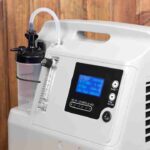 Medical Oxygen at Home: Essential Information on Oxygen Tanks, Machines, and TherapiesIntroduction For individuals with chronic respiratory conditions, such as COPD, asthma, or emphysema, medical oxygen therapy at home is often a critical part of maintaining health and improving quality of life. Whether you need an oxygen machine for […]
Medical Oxygen at Home: Essential Information on Oxygen Tanks, Machines, and TherapiesIntroduction For individuals with chronic respiratory conditions, such as COPD, asthma, or emphysema, medical oxygen therapy at home is often a critical part of maintaining health and improving quality of life. Whether you need an oxygen machine for […]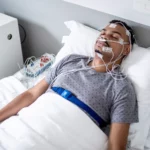 Understanding Sleep Apnea: Causes, Symptoms, and Effective TreatmentsSleep is one of the most vital pillars of good health, but for millions of people, restful sleep is harder to achieve than it should be. One of the most common reasons for poor sleep quality is sleep apnea, a potentially serious sleep disorder that often […]
Understanding Sleep Apnea: Causes, Symptoms, and Effective TreatmentsSleep is one of the most vital pillars of good health, but for millions of people, restful sleep is harder to achieve than it should be. One of the most common reasons for poor sleep quality is sleep apnea, a potentially serious sleep disorder that often […]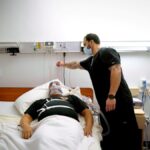 Bulk-Bill Sleep Study Brisbane: Affordable Options for LocalsWhat Are Bulk-Bill Sleep Studies and How Do They Work in Brisbane? Bulk-bill sleep study Brisbane services provide you with direct billing to Medicare, eliminating upfront costs for diagnostic testing. When you receive a bulk-bill sleep study, the […]
Bulk-Bill Sleep Study Brisbane: Affordable Options for LocalsWhat Are Bulk-Bill Sleep Studies and How Do They Work in Brisbane? Bulk-bill sleep study Brisbane services provide you with direct billing to Medicare, eliminating upfront costs for diagnostic testing. When you receive a bulk-bill sleep study, the […] Sleep Apnea Test Adelaide: Early Diagnosis for Better HealthWhat Is Sleep Apnea and Why Is Early Diagnosis Important? Sleep apnea is a serious sleep disorder where your breathing repeatedly stops and starts during sleep. This condition affects millions of people worldwide, yet many remain undiagnosed, missing […]
Sleep Apnea Test Adelaide: Early Diagnosis for Better HealthWhat Is Sleep Apnea and Why Is Early Diagnosis Important? Sleep apnea is a serious sleep disorder where your breathing repeatedly stops and starts during sleep. This condition affects millions of people worldwide, yet many remain undiagnosed, missing […]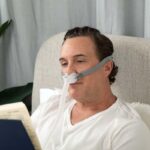 Sleep Apnea Explained: Causes, Symptoms, and Treatment OptionsIntroduction: Why Sleep Apnea Deserves Your Attention Picture this: you go to bed at a reasonable hour, expecting a full night’s rest, yet you wake up feeling drained, irritable, and foggy-headed. It’s not just “bad sleep” — it could be sleep apnea, a […]
Sleep Apnea Explained: Causes, Symptoms, and Treatment OptionsIntroduction: Why Sleep Apnea Deserves Your Attention Picture this: you go to bed at a reasonable hour, expecting a full night’s rest, yet you wake up feeling drained, irritable, and foggy-headed. It’s not just “bad sleep” — it could be sleep apnea, a […]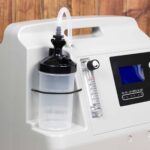 Top 5 Online Stores to Purchase a Portable Oxygen Concentrator MachinePortable oxygen concentrators (POCs) have become essential devices for individuals with respiratory conditions, providing a convenient and reliable source of oxygen. With the rise of e-commerce, purchasing a POC has never been easier. However, selecting […]
Top 5 Online Stores to Purchase a Portable Oxygen Concentrator MachinePortable oxygen concentrators (POCs) have become essential devices for individuals with respiratory conditions, providing a convenient and reliable source of oxygen. With the rise of e-commerce, purchasing a POC has never been easier. However, selecting […] Portable Oxygen Concentrator Australia: Features and BenefitsIn recent years, the demand for portable oxygen concentrators (POCs) has surged in Australia, largely due to the increasing prevalence of respiratory conditions and the need for greater mobility among patients. These devices provide a continuous supply […]
Portable Oxygen Concentrator Australia: Features and BenefitsIn recent years, the demand for portable oxygen concentrators (POCs) has surged in Australia, largely due to the increasing prevalence of respiratory conditions and the need for greater mobility among patients. These devices provide a continuous supply […]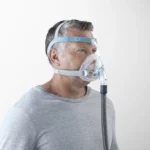 CPAP Masks Australia: A Comprehensive Guide to the Best Options AvailableContinuous Positive Airway Pressure (CPAP) therapy is a common and effective treatment for obstructive sleep apnea. One crucial component of this therapy is the CPAP mask, which delivers the airflow necessary to keep the airways open during sleep. In […]
CPAP Masks Australia: A Comprehensive Guide to the Best Options AvailableContinuous Positive Airway Pressure (CPAP) therapy is a common and effective treatment for obstructive sleep apnea. One crucial component of this therapy is the CPAP mask, which delivers the airflow necessary to keep the airways open during sleep. In […]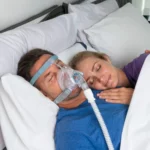 CPAP Mask Online Shopping: How to Ensure You’re Choosing the Right Mask for YouChoosing the right CPAP mask for your needs is essential for effective sleep apnea treatment. With the convenience of online shopping, it’s possible to find various options without stepping out of your home. However, the multitude of choices available […]
CPAP Mask Online Shopping: How to Ensure You’re Choosing the Right Mask for YouChoosing the right CPAP mask for your needs is essential for effective sleep apnea treatment. With the convenience of online shopping, it’s possible to find various options without stepping out of your home. However, the multitude of choices available […] Discovering Your Sleep Type: The Benefits of a Sleep Type TestDo you often find yourself tossing and turning at night, struggling to fall asleep? Or maybe you drift off to dreamland effortlessly but still wake up feeling groggy and exhausted. If either of these scenarios sounds familiar, it's possible that you […]
Discovering Your Sleep Type: The Benefits of a Sleep Type TestDo you often find yourself tossing and turning at night, struggling to fall asleep? Or maybe you drift off to dreamland effortlessly but still wake up feeling groggy and exhausted. If either of these scenarios sounds familiar, it's possible that you […]

